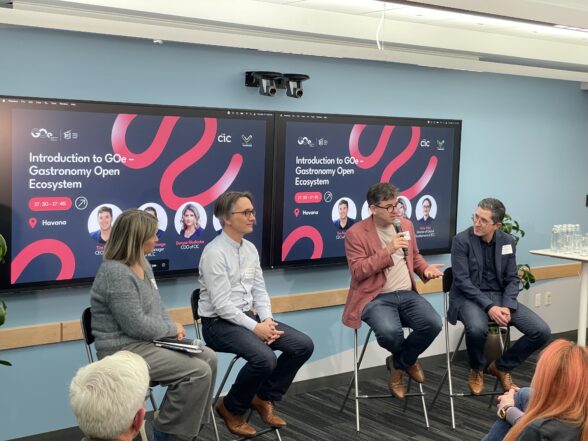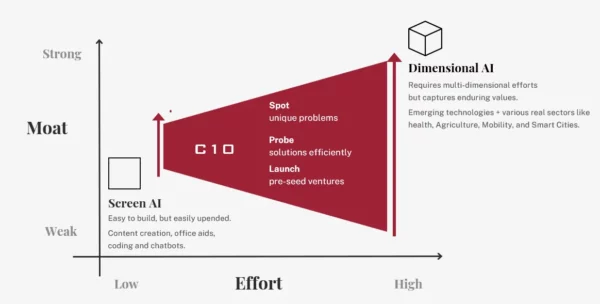By Choya Amenkhienan
So you did it. You’ve grown your business to the point where you need additional hands on deck full-time. But you can’t just let anyone join the team. This is your baby. How do you go about building out your team beyond your loyal co-founders?
Or maybe you’re an eager candidate looking for an opportunity at a buzzing startup. You’re experienced and enthusiastic, but know that businesses at this stage are very selective. How do you go about endearing yourself to the discerning founding team?
You are likely already aware of the cost of a bad hire. While larger, more established companies are better equipped to absorb the associated financial and productivity costs, an early-stage startup can crumble under the weight of even one bad hire.
We reached out to three experienced entrepreneurs from the CIC community to get their thoughts on when, why, and how to hire that first non-founder employee. Contributors include Jane Hiscock, President of Farland Group; Josh Schanker, CEO of BookBub; Michele Brown, CEO of Quality Interactions; and our own CEO, Tim Rowe.
What were the signs that you were ready to hire your first employee and not a contractor?
JH: Farland Group is a different company from many of the CIC companies in that we are 100% consulting and therefore our product is our people. When I started Farland Group in November 2009, the U.S. unemployment rate hit double-digits for the first time in 26 years and there was a lot of debate and discussion about when the U.S. economy would expand. It was not the smartest time to start a consulting firm…or maybe it was the best time in hindsight.
With that economic backdrop, I was cautious to not hire any consulting talent until we had revenue. Fortunately, we landed our first clients very quickly and I was then able to hire two full-time employees in early 2010. For Farland Group it was about committed revenue. If we were a venture-backed product-driven business, it would have been a different scenario.
JS: I’ve started a few companies and generally I’ve hired our first employee once we’ve started getting real traction or product-market fit in the business. This moment has typically occurred once we have a product or service that our customers would be very upset if we took it away from them—at that point I know we have something that’s not going away tomorrow, which has given me the comfort to grow the team beyond the founders.
MB: At Quality Interactions, our three co-founders, Drs. Joseph Betancourt, Alexander Green, and Emilio Carillo, have well-established careers in medicine and are pioneers in health disparity research. I was hired initially as chief operating officer and then promoted to chief executive officer when they recognized that the complexities of running the business required full-time and focused leadership—something not generally found in independent consultants.
TR: That’s easy. I always prefer hiring employees to contractors. If I’m building a company, I expect it to be around and grow. Employees are more invested in the mission of the company than contractors. And every day that an employee is with you, they are learning. An employee—someone who stays with you a long time—can employ that learning to good effect.Contractors will usually go pretty quickly, and you lose the learning. So… when you get too busy to handle everything that comes at you, and if you have the funds, go for it and hire an employee. You’ll never look back.
What did you find to be best practices for getting the word out?
JH: I went with known talent. I hired two people that I’d worked with in prior consulting firms—I trusted them both and knew they would commit to the success of the company in good times and in tough times. They are still with Farland Group today and are critical to our success.
The hiring we did after the first two was more challenging. Getting the word out in 2009–2011 was quite different from what it is today. The job market today is much hotter and much more competitive. I’ve learned many best practices from others at CIC:
- Create a job description that is clear.
- Use every channel possible—social channels, attending events and talking with people, telling and retelling your network (people forget who is looking when).
- Try new things—we tried this new site called Poachable. It uses an analytics-driven approach to hiring. It didn’t find our latest employee, but it was another path that we hadn’t tried before.
JS: How I’ve hired has depended on the role, but for early hires, recruiting through my personal network has generally been most effective. It has allowed me to get friends to vouch for me with candidates so they feel more comfortable taking a chance with their career on a nascent company.
MB: Quality Interactions reached out to their extensive network, leveraging the relationships they enjoyed with people who knew them and who could recommend candidates who had the requisite skills and who would be a good fit for the company.
TR: We did a lot of our early hiring on CraigsList. Still do. Sure, tell your friends and tweet, but you may find that your personal network is not as broad as you think it is. CraigsList reaches a LOT of people, and can help you find great candidates. Just be really specific in your posting about what you want, so you don’t get a lot of applicants who are not appropriate. If you see too many applicants, make your description more specific.
Founders tend to be the most passionate about the enterprise. How did you deal with the difficulty of hiring someone who may not initially be as emotionally invested as the founders? Did you find unique solutions other than offering equity?
JH: We are lucky; we get to work with great clients, learn about their business, and then work with their top clients to advise their strategy. To be passionate about what we do requires us to hire curious minds and from there we find that the passion emerges. Each employee’s passion for our business may not be the same as my passion, but we have a business model that really allows every employee to learn and grow at their own pace.
We have a typical consulting business model that provides employees with profit-sharing when we have strong years. This provides the incentive around helping to retain, grow, and delight our clients. Our employees see the return on that investment.
JS: The line between a first employee and co-founder is generally very blurry, and for that reason I’ve looked for people who have the qualities I’d expect to find in a co-founder—passion for the business, excited to build something from scratch, flexible to wear many hats, someone I can really trust, etc.
MB: Our founders are quite passionate about the work they do—helping health professionals become proficient in cultural competency. The aim is to bolster patient experience and patient satisfaction to improve health outcomes. It was important that I shared a commitment to their mission. Beyond financial compensation and equity, it is essential that the non-founder leaders be given the opportunity to “earn a seat at the table.” This requires patience and the establishment of trust between founders and non-founder leaders.
TR: I’ve actually found that employees are just as committed as founders. Most people—at least most people I would want to work with—are motivated more by purpose, work environment, and opportunity for impact than anything else.
What is one thing you wish you could tell your younger self before hiring your first employee?
JH: To be patient (I’d have to tell my older self that as well) and hold true to the values and goals of the business. If you hire quickly and cut corners it often ends up being a poor fit for the company and for the new hire.
JS: I’ve been fortunate with all of the first employees that I’ve hired so I don’t have any regrets, but I think that’s partially because my co-founders and I have set a very high bar for hiring that initial role. If we hadn’t been so careful, I think I would have a lot more constructive advice for my younger self!
MB: One thing that I have learned in my journey is that relationships are everything. As a non-founder leader, I invested time in understanding the culture the co-founders created, I processed how decision making took place, and I worked with them to establish transparency and clear communications.
TR: If you can, find someone to help you with the hiring process. It can be a ton of work. Even having someone to just read resumes, do a first phone call with potential applicants, or maybe have the first interview can dramatically cut down the amount of time (as a busy founder) required to find great employees. Ask a friend or relative to pitch in for these first key hires.




